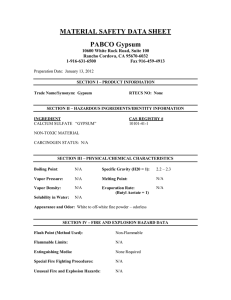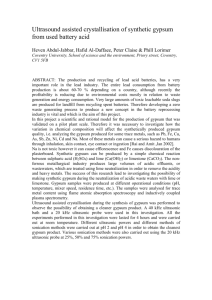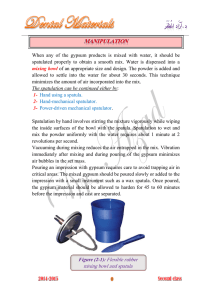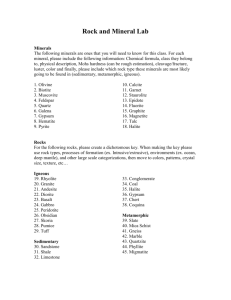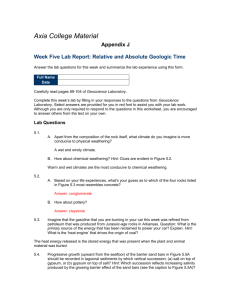Fire Resistance of Wood Members with Directly Applied Protection Robert H. White
advertisement
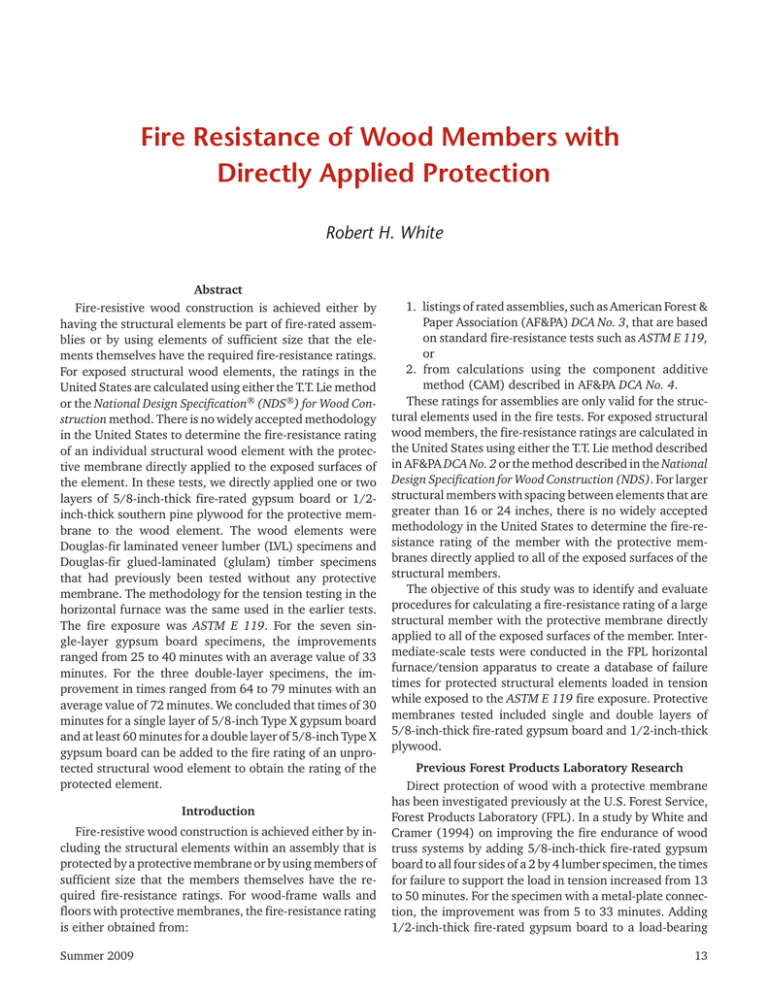
Fire Resistance of Wood Members with Directly Applied Protection Robert H. White Abstract Fire-resistive wood construction is achieved either by having the structural elements be part of fire-rated assemblies or by using elements of sufficient size that the elements themselves have the required fire-resistance ratings. For exposed structural wood elements, the ratings in the United States are calculated using either the T.T. Lie method or the National Design Specification® (NDS®) for Wood Construction method. There is no widely accepted methodology in the United States to determine the fire-resistance rating of an individual structural wood element with the protective membrane directly applied to the exposed surfaces of the element. In these tests, we directly applied one or two layers of 5/8-inch-thick fire-rated gypsum board or 1/2inch-thick southern pine plywood for the protective membrane to the wood element. The wood elements were Douglas-fir laminated veneer lumber (LVL) specimens and Douglas-fir glued-laminated (glulam) timber specimens that had previously been tested without any protective membrane. The methodology for the tension testing in the horizontal furnace was the same used in the earlier tests. The fire exposure was ASTM E 119. For the seven single-layer gypsum board specimens, the improvements ranged from 25 to 40 minutes with an average value of 33 minutes. For the three double-layer specimens, the improvement in times ranged from 64 to 79 minutes with an average value of 72 minutes. We concluded that times of 30 minutes for a single layer of 5/8-inch Type X gypsum board and at least 60 minutes for a double layer of 5/8-inch Type X gypsum board can be added to the fire rating of an unprotected structural wood element to obtain the rating of the protected element. Introduction Fire-resistive wood construction is achieved either by including the structural elements within an assembly that is protected by a protective membrane or by using members of sufficient size that the members themselves have the required fire-resistance ratings. For wood-frame walls and floors with protective membranes, the fire-resistance rating is either obtained from: Summer 2009 1. listings of rated assemblies, such as American Forest & Paper Association (AF&PA) DCA No. 3, that are based on standard fire-resistance tests such as ASTM E 119, or 2. from calculations using the component additive method (CAM) described in AF&PA DCA No. 4. These ratings for assemblies are only valid for the structural elements used in the fire tests. For exposed structural wood members, the fire-resistance ratings are calculated in the United States using either the T.T. Lie method described in AF&PA DCA No. 2 or the method described in the National Design Specification for Wood Construction (NDS). For larger structural members with spacing between elements that are greater than 16 or 24 inches, there is no widely accepted methodology in the United States to determine the fire-resistance rating of the member with the protective membranes directly applied to all of the exposed surfaces of the structural members. The objective of this study was to identify and evaluate procedures for calculating a fire-resistance rating of a large structural member with the protective membrane directly applied to all of the exposed surfaces of the member. Intermediate-scale tests were conducted in the FPL horizontal furnace/tension apparatus to create a database of failure times for protected structural elements loaded in tension while exposed to the ASTM E 119 fire exposure. Protective membranes tested included single and double layers of 5/8-inch-thick fire-rated gypsum board and 1/2-inch-thick plywood. Previous Forest Products Laboratory Research Direct protection of wood with a protective membrane has been investigated previously at the U.S. Forest Service, Forest Products Laboratory (FPL). In a study by White and Cramer (1994) on improving the fire endurance of wood truss systems by adding 5/8-inch-thick fire-rated gypsum board to all four sides of a 2 by 4 lumber specimen, the times for failure to support the load in tension increased from 13 to 50 minutes. For the specimen with a metal-plate connection, the improvement was from 5 to 33 minutes. Adding 1/2-inch-thick fire-rated gypsum board to a load-bearing 13 sandwich panel (plywood faces) increased the ASTM E 119 failure times from 3 to 24 minutes in a study by Eickner (1975). More recently, the use of gypsum board to improve the fire resistance of engineered wood rim board products was investigated by White (2003). Adding a single layer of 5/8-inch-thick fire-rated gypsum board increased the times for 572°F (300°C) on the back of a 1-1/8-inch-thick oriented strandboard (OSB) from 37 to 76 minutes and 89 minutes (two tests). A double layer of 5/8-inch-thick firerated gypsum board increased the time to 134 minutes. Calculation Procedures Procedures for assigning a fire-resistance rating to a wood member with a protective membrane directly applied are of two general types. The first type of procedure is an additive method in which the time for the protective membrane is simply added to the fire-resistance rating of the structural wood membrane without any protection. At the conclusion of that duration, one is assuming the charring of protected wood member proceeds as it would for an exposed wood member. The second type of procedure uses an equation for the char rate for the wood beneath the protective membrane to obtain the reduced sectional area. Since the T.T. Lie method does not allow the adjustment of the char rate, the adjusted char rate is then used in the NDS method to obtain the time for structural failure of the protected structural wood element. All of the procedures are based on the type and thickness of the protective membrane and possibly the structural elements. The fasteners or other methodology for attaching the membrane to the structural elements are not considered in the analyses. Additive Procedures To estimate the fire-resistance ratings of the same element with protective membranes directly applied, data for fire-rated wall and floor assemblies provide two options for values to add to the fire rating of the unprotected structural wood element. One option is to use the finish ratings for the protective membrane obtained in the fire-resistance tests of the wall or floor assemblies. The finish rating of the protective membrane is the resistance time for thermocouples placed between the wood stud or joist and the gypsum board to record a temperature rise of 250°F or individual temperature rise of 325°F. This temperature rise of 250°F corresponds to an actual temperature of 318°F from an initial temperature of 68°F. Because this finish rating temperature is less than the 550°F or 572°F commonly assumed for the base of the char layer, a conservative assumption is that the structural wood element will not char prior to the duration of the finish rating. Finish ratings can be found in product listings such as the Underwriters Laboratories Fire Resistance Directory (www.ul.com). For wood stud wall assemblies, such a finish rating for double layer 5/8-inchthick gypsum board protective membrane includes 66 min for UL Design No. U301. Finish ratings for a single layer of 5/8-inch-thick fire-rated gypsum wall board include 30 14 minutes (UL Design No. L501), 20 to 26 minutes (UL Design No. U305), and 27 minutes (UL Design No. U309). The second option is to use the times assigned to the protective membrane in the component additive method (CAM) for fire-resistance ratings of wood wall and floor assemblies described in AF&PA DCA No. 4. The times for the membranes are from the membrane table of the component additive method (Table 1). In the component additive method, the membrane times are added to the times for 2 by 4 studs, 16 inches on center (o.c.) (20 min.), or 2-inch nominal thick joists, 16 inches o.c. (10 min.). These times for the membranes are based on full-scale ASTM E 119 tests of wall and floor assemblies. Reduced Section Procedures Data for the char rates of wood protected by gypsum board provide modified char-rate equations to use in reduced section methodologies for calculating the fire-resistance rating of structural wood elements. One such equation provided by White (2003) is: T572°F = m1xc + b1 [1] where: xc = char depth from original surface, in. t572°F = time for the 572°F (300°C) assumed for the base of the char layer Values given by White (2003) for the parameters m1 and b1 are listed in Table 2. The NDS method and Equation [1] can be used to calculate the time t572°F for the protected element for the char depth, xc, that corresponds to failure of the structural wood member to support the applied load for the unprotected element. Methods Materials Twelve specimens each with a protective membrane were tested as part of this study (Table 3). For the protective membrane, 5/8-inch-thick fire-rated Type X gypsum Table 1.—Times assigned to protective membrane in the component additive method (CAM of AF&PA DCA No. 4). Protective membrane Assigned time (min.) 3/8-inch-thick Douglas-fir plywood 1/2-inch-thick Douglas-fir plywood 5/8-inch-thick Douglas-fir plywood 3/8-inch-thick gypsum board 1/2-inch-thick gypsum board 5/8-inch-thick gypsum board 1/2-inch-thick Type X gypsum board 5/8-inch-thick Type X gypsum board Double 3/8-inch-thick gypsum boards 1/2- + 3/8-inch-thick gypsum boards Double 1/2-inch-thick gypsum board 5 10 15 10 15 20 25 40 25 35 40 WOOD DESIGN FOCUS board and 1/2-inch-thick southern pine plywood were used. One or two layers of the protective membrane were attached using screws. We used Douglas-fir LVL and Douglas-fir glulam specimens remaining from previous studies in which specimens without protection were tested. The LVL-4 was made by using hot setting phenol-resorcinol-formaldehyde (PRF) adhesive to glue 1/10-inch-thick veneers into 7/8-inch-thick panels in a plywood press. These panels are finger-jointed with a cold setting PRF adhesive and pressed into final product using a cold setting isocyanurate adhesive. The LVL-5 was made with a phenol-formaldehyde adhesive. Prior to testing, the wood products were dried in a room with an ambient atmosphere of 50 percent relative humidity and temperature of 73°F. Test Methodology The tension testing in the intermediate-scale horizontal furnace (Fig. 1) was conducted using the methodology of the earlier tests of the wood elements without any protec- tion. The results for the unprotected Douglas-fir LVL tests were reported by White (2006) and results for the unprotected glulam specimen was reported by White (2004) (Table 4). In the fire tests, the specimens were exposed to a natural gas fire that was controlled so the temperatures determined by thermocouples in six capped pipes followed the standard ASTM E 119 time–temperature curve while the specimen was also subjected to a constant tensile load. Due to the limitations of the bolted connections (Fig. 2) outside the furnace, the load levels were restricted to values less than the full allowable load determined in accordance with the NDS (Table 3). The low load for tests one and two reflected the load used in the original test of a specimen without protection. Its load was low because initial application of a higher load resulted in failure of the bolted connection. Table 2.—Char-rate parameters for Equation [1] from White (2003). Protective membrane Single layer of 1/2-inch-thick Type X gypsum board Single layer of 5/8-inch-thick Type X gypsum board Double layer of 1/2-inch-thick Type X gypsum board Double layer of 5/8-inch-thick Type X gypsum board m1 b1 (min./in.) (min.) 38.48 19.3 46.56 23.8 57.58 56.4 51.89 71.7 Figure 1.—Specimen in intermediate-scale horizontal furnace. Table 3.—List of test specimens and amount of applied load. Membrane Typea Test no. Wood specimen No. Typeb Width Height - - - - - - - - - (in.) - - - - - - - - 1 2 3 4 5 6 7 8 9 10 11 12 Gypsum board Gypsum board Gypsum board Gypsum board Gypsum board Gypsum board Gypsum board Gypsum board Gypsum board Gypsum board Plywood Plywood 1 1 1 1 1 1 1 2 2 2 2 1 LVL-5 LVL-5 LVL-5 Glulam LVL-4 LVL-4 LVL-4 LVL-5 Glulam LVL-4 LVL-5 LVL-5 1.75 1.75 3.5 5.0 5.25 7.0 7.0 3.5 5.0 5.25 5.25 5.25 9.5 9.5 9.5 9.0 9.5 9.5 9.5 9.5 9.0 9.5 9.5 9.5 Load Percent allowable load (kips) 2.0 2.0 19.9 34.2 25.8 39.1 39.6 19.8 33.9 25.8 20.1 20.3 7.4 7.5 32.9 48.2 25.4 28.8 29.3 32.4 49.1 25.9 23.6 24.0 a Plywood was 1/2-inch-thick, southern pine C-D plywood. Gypsum board was 5/8-inch-thick USG Sheetrock brand Firecode core Type X, (Type SCX). b The LVL and glulam specimens were Douglas-fir. The number refers to material number cited in White (2006) and reflects two different manufacturers. Summer 2009 15 Table 4.—Test results for unprotected specimens previously tested. Test no.a Wood specimenb Width Height - - - - - - - (in.) - - - - - - 7 5 6 5 3 4 a b c LVL-5 LVL-5 LVL-5 Glulam LVL-4 LVL-4 5.0 1.75 3.50 5.0 5.25 7.0 9.25 9.5 9.5 8.8 9.5 9.5 Applied load Percent allowable (kips) 20.3 2.0 19.9 34.4 25.6 7.0 24 8 33 48 25 30 Failure times Estimated char depth at failurec (min.) (in.) 68 21 46 58 73 77 1.7 0.7 1.2 1.5 1.8 1.9 From White (2006) for the LVL specimens and White (2004) for the glulam specimen. See Table 1 for additional information. Calculated from the observed failure times and the char rates reported in White (2006) for the LVL specimens and White (2004) for the glulam specimen. Figure 2.—Bolted connection of specimen to tension apparatus. A single layer of the Type X gypsum board was installed on the wide 9.5-inch surfaces so it overlaps the gypsum board on the narrow edges. We installed 7 feet of a single 8-foot length (no joints) of gypsum board lengthwise on each specimen, centered at mid-length. There was no taping of gypsum board. The screws were Type S wall board screws, 2-1/4-inch Type S, No. 7 except for the 1-3/4inch-wide specimens. A screw length of 1-5/8 inches for the 1-3/4-inch-thick specimen was used. Spacing along the length of the specimen was 12 inches o.c. One at mid-length, then 12 inches from mid-length, 24 inches from mid-length, and 36 inches from mid-length. There were no screws at the ends of gypsum, i.e., 3-1/2 feet from midlength. The two screws on top and bottom of the wide surfaces 9-1/2-inch surface were 7/8 inch from wood edge (or 1-1/2-inch from the edge of the 5/8-inch-thick gypsum board edge.) Screws on narrow edge pieces were one row of screws down the middle for the 1-3/4-inch specimens. For the 3-1/2-, 5-1/4-, and 7-inch-wide specimens, two rows of screws, 7/8 inch from each of the two wood edges down the length. We off-set the two rows of the screws down the length of the member (i.e., one-half of 12-inch spacing be16 tween screws of two rows). For both rows, one was at 36 inches from mid-length. For the double layer of 5/8-inch Type X gypsum board, we installed the first layer similar to the single layer with the screws 12 inches o.c., except the screws started at 6 inches from mid-length. The spacing of screws for the second layer alternated at the 12 inches o.c. placement of screws with that of the first layer; i.e., the second layer of the double layer was like the single-layer placement of screws. The second layer was placed with screws at 36 inches from mid-length. We overlapped the wider sides of the gypsum of the first layer with the second layer on narrow edges. Screws were 3/4 inch from wood edge (or 2 inches from the edge of the outer 5/8-inch-thick gypsum board edge). For the double layer gypsum board specimens, an additional row of screws was added at mid-height. The 1/2-inch-thick plywood was attached in a manner similar to gypsum board. The plywood was southern pine C-D plywood. There were no joints within any of the protective membranes installed on a given face of a test specimen. Additional thermocouples were inserted on a specimen between the wood and the gypsum board (or plywood). Eight thermocouples were attached to the wood member. Two thermocouples were placed on each of the four surfaces: one coming out the north end and one coming out the south end of the test specimen. Each thermocouple was located 12 inches from mid-length, and at mid-width of each surface. The thermocouple was attached with tape. Results and Discussion For the seven single-layer gypsum board specimens, the improvements ranged from 25 to 40 minutes with an average value of 33 minutes (Table 5). The results for the finish ratings ranged from 21 to 23 minutes with an average of 22 minutes. The 5/8-inch-thick USG Sheetrock brand Firecode core Type X (Type SCX) has a listed finish rating of 24 minutes in UL Design U305. The times for a temperature of 572°F at the interface ranged from 28 to 30 minutes with an average of 29 minutes. For the three double-layer gypsum board specimens, the improvement in times ranged from 64 WOOD DESIGN FOCUS Table 5.—Test results for protected specimens. Test no. Membrane Typea No. Wood specimena Failure time Unprotected failure times Increase Finish rating Average time for 572°F - - - - - - - - - - - - - - - - - - - - - - - - (min.) - - - - - - - - - - - - - - - - - - - - - - 1 2 3 4 5 6 7 8 9 10 11 12 a Gypsum board Gypsum board Gypsum board Gypsum board Gypsum board Gypsum board Gypsum board Gypsum board Gypsum board Gypsum board Plywood Plywood 1 1 1 1 1 1 1 2 2 2 2 1 LVL-5 LVL-5 LVL-5 Glulam LVL-4 LVL-4 LVL-4 LVL-5 Glulam LVL-4 LVL-5 LVL-5 54 54 87 89 98 108 114 125 131 136 84 77 21 21 46 58 73 77 77 46 58 73 68 68 33 33 40 31 25 30 36 79 73 64 15 8 21 23 23 23 21 23 23 52 -56 15 9 29 29 30 29 28 30 30 63 64 66 20 12 See Table 1 for additional information. Figure 3.—Regression of failure times with the width of the unprotected wood element. to 79 minutes with an average value of 72 minutes. Two of the results for the finish ratings were 52 and 56 minutes with an average of 54 minutes. These results are less than the 66 minute finish rating listed for UL Design U301. There was some discrepancy in the finish rating data for test no. 9. The times for a temperature of 572°F at the interface ranged from 63 to 66 minutes with an average of 64 minutes. The improvements with the 1/2-inch-thick plywood as the protective membrane were 8 minutes for a single layer and 15 minutes for a double layer. The finish ratings from the thermocouples between the wood and the membrane were 9 minutes for the single layer and 15 minutes for the double layer. The corresponding times for a temperature of 572°F at the interface were 12 and 20 minutes. Additional tests of wood elements protected with wood panel products are being conducted. Summer 2009 Additive Models A simple model for estimating the fire-resistance ratings of wood elements with protective membranes is to assign values to the different types of membranes and add those assigned values to the fire-resistance ratings of the structural wood member without any protective membrane. As just discussed, the average improvements were 33 minutes for the single layer of 5/8-inch-thick Type X gypsum board and 72 minutes for two layers of 5/8-inch-thick Type X gypsum board. Various regression models were investigated. In one model there are separate lines for the zero, one, and two layers of gypsum board, but the slope of the failure times with the width of the structural wood element is the same for all three lines (Fig. 3). The 10 tests with gypsum board (Table 5) and the six tests with no protection (Table 4) were included in the data set for the regression analysis. 17 Figure 4.—Effect of test duration on improvement. The slope of the three lines is 10.36 min./in. The y-intercept of the line for the unprotected elements was 8.2 minutes. The y-intercept for the wood elements with one layer of gypsum board was 39.5 minutes or 31.3 minutes greater than the y-intercept for the specimens tested with no protective membranes. The y-intercept for the wood elements with two layers of gypsum board was 83.1 minutes or 74.9 minutes greater than the y-intercept for the specimens tested with no protective membranes. The R2 for this model was 0.978 and the coefficient of variation for the predicted failure times was 6.8 percent. Using only the data for elements without protection (Table 4), the regression of failure times with the width of the element had a R2 of 0.94 and predictive coefficient of variation of 11.8 percent. Adding the percentage allowable load to the model did not improve the results. Using only the 10 tests with gypsum board (Table 5), regression analysis was done on the failure times with two variables including a variable with value of 0 for two layers and 1 for one layer and the failure times for the corresponding element without protection. The R2 was 0.97 and the predictive coefficient of variation was 5.6 percent. The model assigned a value of 38.0 minutes for one layer gypsum board and 77.7 minutes for two layers gypsum board and a slope of +22.86 min./in. for the unprotected wood element failure time variable. Besides the number of layers of gypsum board, other factors did not provide meaningful improvements to regression models for the increases in failure times because of the protection. Analysis of the data indicated that improvements provided by two layers of gypsum board decreased with the increase in failure times for the unprotected element (Fig. 4) and similar variables such as failure times for the protected elements. This likely is due to physical loss of the outer layer of the gypsum board during the test. The improvements provided by one layer were not 18 similarly affected by the failure times of the unprotected element (Fig. 4). Physical Failure of Membrane The screws used for most of the tests were 2-1/4 inch long. With the single layer of gypsum board, this resulted in a wood penetration depth of 1.57 inches. For the double layer of gypsum board, the wood penetration was approximately 1 inch. For the 1-3/4-inch-wide specimens, the screws were 1-5/8 inches long, which resulted in a wood penetration depth of 1 inch. Visual observation of the specimens during the tests was very limited. During the tests of the single-layer gypsum board specimens of wood element thickness greater than 1-3/4 inches, observations of gypsum board on the floor of the furnace were made between 49 and 60 minutes and an average of 55 minutes. In the case of two of the double-layer tests, such observations were made at 60 minutes in one test and 111 minutes in another test. The char depths were calculated from the observed failure times and the char rates reported in White (2006) for the LVL specimens and White (2004) for the glulam specimen (Table 4). The estimated char depth at failure for the 1-3/4-inch-wide specimens was 0.67 inch, and no observation of physical failure of the gypsum board was observed in these tests. The estimated char depths at failure of the other widths ranged from 1.2 to 1.9 inches. Using the char-rate parameters of Table 2 for a single layer of gypsum board, the observation of physical failure of the gypsum board at 55 minutes would correspond to a char depth of 0.7 inch. Reduced Section Models An alternative approach is to use char-rate equations to calculate the reduced cross-sectional area and directly incorporate the char depth results into reduced section fire-resistance models such as the NDS method. Compared with char-rate data for wood without protection, there is WOOD DESIGN FOCUS Figure 5.—Comparison of char depths calculated for the protected wood elements with data for unprotected wood elements. very limited data for the char rate beneath layers of gypsum board. One such set of data is that obtained in tests of structural rim boards (White 2003) (Eq. [1] and Table 2). These equations for char rates beneath layers of gypsum board were used to calculate the expected char depths at the times of failure of the protected elements listed in Table 5. Using char rates and failure times of the unprotected specimens from White (2004, 2006) (Table 4), the estimated char depths at their times of failure were also calculated. The corresponding char depths are compared in Figure 5. Whereas there was good agreement for the one layer gypsum board data, the equation for the two layers of 5/8inch-thick Type X gypsum board (Table 2) overestimated the protection provided by the gypsum board. This might reflect physical failure of the outer layer of gypsum board during the tensile tests, which would reduce the thermal protection and increase the char rate. Conclusions We concluded that the fire-resistance rating of a structural wood element with a protective membrane directly applied to all of the fire exposed surfaces can be obtained using a simple additive method of adding a fixed time for the protective membrane to the fire-resistance rating of the unprotected element. The tests indicated that times of 30 minutes for a single layer of 5/8-inch Type X gypsum board and at least 60 minutes for a double layer of 5/8-inch Type X gypsum board will result in estimates for the fire-resistance rating of the protected structural wood element consistent with the failure times observed in the tensile fire-resistance tests of protected structural wood elements. The failure times ranged from 54 to 136 minutes. The fasteners used to attach the gypsum board were Type S, No. 7 wallboard screws with a length of 2-1/4 inches and the spacing of the fasteners was 12 inches o.c. Summer 2009 Acknowledgment Partial funding for this study was provided by the American Wood Council of the American Forest & Paper Association. The test materials were provided to FPL by the manufacturers in conjunction with other studies. Literature Cited Eickner, H.W. 1975. Fire endurance of wood-frame and sandwich wall panels. J. of Fire and Flammability, 6, pp. 155-190. White, R. and S. Cramer. 1994. Improving the fire endurance of wood truss systems. In: Pacific Timber Engineering Conference 94: Timber Shaping the Future. Štrbské Leso, April 18-22, 2004. Zvolen, Slovak Republic: Technical Univ. of Zvolen, Faculty of Wood Science and Technology. Vol. 1, pp. 582-589. White, R.H. 2003. Fire resistance of engineered wood rim board products. Res. Paper 610, USDA Forest Service, Forest Products Laboratory, Madison, WI. White, R.H. 2004. Fire resistance of exposed wood members. 5th International Wood & Fire Safety Conference, Gold Coast, Australia, July 11-15, 1994. Fortitude Valley, Australia: Timber Research and Development Advisory Council. pp. 337-344. White, R.H. 2006. Fire resistance of structural composite lumber products. Res. Pap. FPL-RP-633, USDA Forest Service, Forest Products Laboratory, Madison, WI. Robert H. White, Research Wood Scientist, USDA Forest Service, Forest Products Laboratory, Madison, Wisconsin. This paper is a slightly abbreviated version of a paper that originally appeared in the Proceedings of the Fire and Materials 2009 Conference held at the Hyatt Hotel Fisherman’s Wharf Hotel, San Francisco, California, January 26–28, 2009, organized by Interscience Communications Ltd. Original units were in metric and were converted to the inch-pound system. The original paper is available online at: www.fpl.fs. fed.us/documnts/pdf2009/fpl_2009_white001.pdf. 19

